Introduction
Thai Red Curry with Shrimp & Coconut Milk is not just a dish—it’s a celebration of bold flavors that transports you straight to the heart of Thai culinary traditions. The vibrant mix of succulent shrimp, creamy coconut milk, and aromatic curry paste creates an unforgettable experience every time you make Thai Red Curry with Shrimp & Coconut Milk.
In this article, we will explore:
- The rich history behind Thai Red Curry with Shrimp & Coconut Milk.
- A detailed breakdown of each ingredient used in Thai Red Curry with Shrimp & Coconut Milk.
- Step-by-step instructions to prepare and cook Thai Red Curry with Shrimp & Coconut Milk.
- Variations to tailor Thai Red Curry with Shrimp & Coconut Milk to your taste.
- Practical tips and troubleshooting advice for perfecting Thai Red Curry with Shrimp & Coconut Milk.
For more recipes and inspiration, visit our Coconut Cake with Walnuts Recipes
The Origins & History of Thai Red Curry
The history of Thai Red Curry with Shrimp & Coconut Milk is as colorful as its ingredients. This dish has evolved over centuries, influenced by trade, migration, and the unique culinary traditions of various regions in Thailand. Its origins can be traced back to ancient culinary practices where the blending of local spices and exotic flavors created dishes that were both robust and delicate.
The evolution of Thai Red Curry with Shrimp & Coconut Milk is a testament to the dynamic interplay of tradition and innovation in Thai culinary history. Understanding its background not only enriches your cooking experience but also connects you to a rich cultural legacy.
Key Ingredients Breakdown
A successful Thai Red Curry with Shrimp & Coconut Milk relies on a perfect balance of high-quality ingredients. Every component plays a crucial role in creating the dish’s signature flavor.
Seasonings such as fish sauce and a touch of palm sugar help balance the complex flavors of Thai Red Curry with Shrimp & Coconut Milk.
Shrimp:
Use fresh, high-quality shrimp to ensure that Thai Red Curry with Shrimp & Coconut Milk has the ideal texture and flavor.
Both large and small shrimp can be used, with larger ones providing a meatier bite.
Coconut Milk:
The creamy coconut milk is essential in Thai Red Curry with Shrimp & Coconut Milk, lending a rich and smooth consistency.
Its natural sweetness balances the heat from the curry paste.
Thai Red Curry Paste:
The core flavor of Thai Red Curry with Shrimp & Coconut Milk comes from its homemade or high-quality pre-made curry paste.
The paste includes ingredients like red chili, garlic, lemongrass, galangal, and kaffir lime leaves.
Herbs & Aromatics:
Fresh Thai basil, cilantro, and kaffir lime leaves enhance Thai Red Curry with Shrimp & Coconut Milk with their aromatic qualities.
These herbs add a zesty brightness that cuts through the creamy sauce.
Additional Ingredients:
Vegetables like bell peppers, bamboo shoots, and sometimes eggplant provide texture and color.
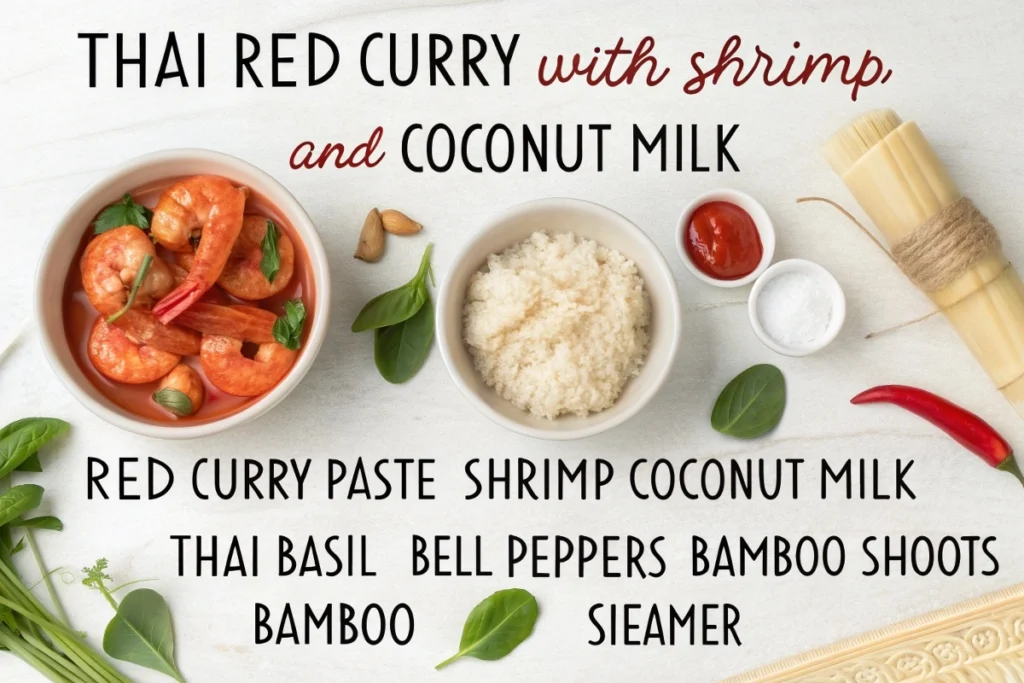
Essential Equipment & Preparation Tips
Before you begin cooking, ensure you have the right tools and follow essential preparation tips that will make the cooking process smoother and more enjoyable:
- Necessary Kitchen Tools:
- Wok or Deep Skillet: A wok is ideal for evenly distributing heat and achieving the perfect sauté for your curry paste.
- Saucepan: Use a medium-sized saucepan for simmering the coconut milk and integrating the flavors.
- Cutting Board and Knives: Precision in chopping herbs, vegetables, and shrimp is key.
- Preparation Tips:
- Prepping the Shrimp: Rinse the shrimp and pat them dry.
- Devein and peel if necessary, ensuring they are ready to be added to the dish.
- Balancing Flavors: Measure out your curry paste accurately.
- Have all your herbs and aromatics prepped in small bowls for easy access during cooking.
- Making Curry Paste from Scratch: If you’re up for a culinary adventure, consider making your own Thai red curry paste.
- Blend fresh ingredients like red chili, garlic, lemongrass, and kaffir lime leaves for a more authentic flavor profile.
- Using Pre-made Paste: For a quicker version, opt for a high-quality pre-made paste.
- Ensure the paste is free from additives that might alter the taste of your curry.
- Bullet Point Summary of Equipment:
- Wok or Deep Skillet for sautéing.
- Saucepan for simmering.
- Cutting Board & Sharp Knives for precision cutting.
- Blender (if making your own curry paste).
By preparing all the ingredients and tools beforehand, you set the stage for a seamless cooking experience that allows you to focus on the intricate balance of flavors inherent in Thai red curry.
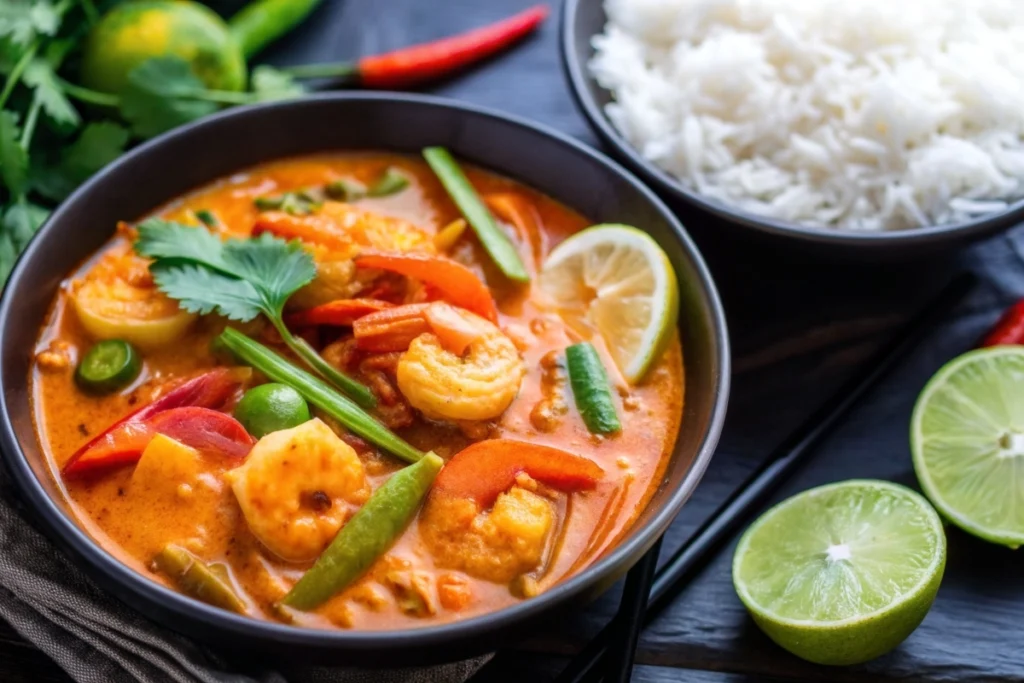
Detailed Recipe & Cooking Method
Now that you have a solid understanding of the background, key ingredients, and necessary equipment, it’s time to roll up your sleeves and get cooking. Follow this step-by-step guide to create a delectable Thai Red Curry with Shrimp & Coconut Milk that bursts with authentic flavors.
Step 1: Prepping the Shrimp
- Clean and Devein: Rinse the shrimp under cold water.
- Remove the shells if desired, but keeping them on can add extra flavor if you prefer.
- Marinate (Optional): Lightly season with a pinch of salt and a squeeze of lime for an extra layer of flavor.
- Set aside for 10 minutes.
Step 2: Sautéing the Curry Paste
- Heat Your Wok: Place your wok or deep skillet over medium-high heat.
- Add a small amount of oil—preferably one with a high smoke point.
- Add the Curry Paste: Introduce your freshly made or pre-made Thai red curry paste.
- Stir constantly, allowing the paste to fry gently and release its aromas.
- Aromatic Infusion: Add chopped garlic, lemongrass, and kaffir lime leaves.
- Sauté until the mixture is fragrant and the spices have softened.
Step 3: Incorporating Coconut Milk
- Pouring the Liquid: Gradually pour in the coconut milk, stirring continuously.
- Allow the mixture to simmer gently, ensuring the paste and milk blend together seamlessly.
- Consistency Check: The sauce should begin to thicken slightly as it simmers.
- Maintain a gentle simmer to avoid rapid boiling which might separate the coconut milk.
Step 4: Adding Vegetables and Shrimp
- Introduce the Vegetables: Add sliced bell peppers, bamboo shoots, and any other preferred vegetables.
- Stir well to coat them in the rich curry sauce.
- Cooking the Shrimp: Add the prepped shrimp to the simmering curry.
- Cook for 3-5 minutes or until the shrimp turns pink and opaque.
- Bullet Points for This Step: Sauté the curry paste until aromatic.
- Gradually add coconut milk and let it blend.
- Stir in vegetables and finally the shrimp.
Step 5: Finishing Touches
- Final Seasoning Adjustments: Add a splash of fish sauce and a small pinch of palm sugar if desired.
- Taste the curry and adjust the seasoning to balance the spices and creaminess.
- Herb Garnishing: Just before serving, sprinkle fresh Thai basil and cilantro over the top.
- Add a few kaffir lime leaves as garnish to enhance the visual appeal.
Step 6: Letting the Flavors Meld
- Simmering: Allow the curry to sit on low heat for a couple more minutes.
- This ensures the flavors meld together, creating a harmonious balance.
- Final Bullet Summary of Cooking Process: Preheat your cooking vessel.
- Sauté the curry paste with aromatics.
- Mix in coconut milk slowly.
- Incorporate vegetables and shrimp.
- Finish with a garnish of fresh herbs.
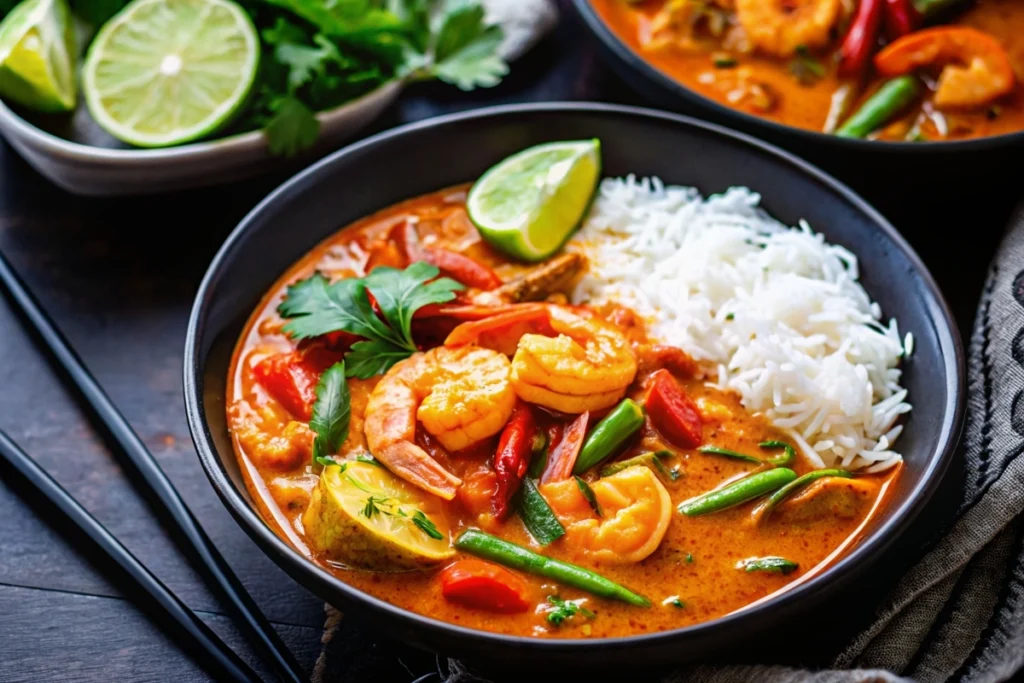
Following these detailed steps will guide you to a perfectly balanced dish that showcases the true essence of Thai red curry. The combination of shrimp, coconut milk, and meticulously prepared curry paste promises a meal that is both visually stunning and richly satisfying.
Recipe Variations & Adaptations
One of the beauties of Thai red curry is its adaptability. You can tweak the recipe to suit different palates or experiment with variations that introduce new flavors while staying true to the dish’s essence.
Variations to Explore:
- Alternative Proteins: Replace shrimp with chicken or tofu if you’re looking to change things up.
- Experiment with a seafood mix for a more eclectic twist.
- Spice Level Adjustments: Adjust the amount of Thai red curry paste to suit your preferred heat level.
- Add extra red chili for those who love an extra kick.
- Vegetable Enhancements: Incorporate additional vegetables such as eggplant or zucchini.
- Use a medley of colorful bell peppers to add visual appeal.
- Herb Variations: Swap out some of the traditional herbs for others like mint or parsley to experiment with the flavor profile.
Adaptation Tips:
- Experimenting with Flavors: Keep a small batch of your base curry sauce and add new ingredients gradually.
- Taste as you go to ensure the balance of spices and creaminess remains intact.
- Cooking for Groups: When cooking for a larger group, prepare the sauce in a big pot and add shrimp or alternative proteins in batches to maintain consistency.
- Bullet Points on Adaptations: Use alternative proteins if desired.
- Adjust the amount of curry paste to control the heat.
- Experiment with additional vegetables.
- Try different herbs for a unique twist.
These variations allow you to make the dish your own while still retaining the heart of traditional Thai red curry. Whether you choose to explore new ingredients or adjust the heat, the core flavors will remain a tribute to classic Thai cuisine.
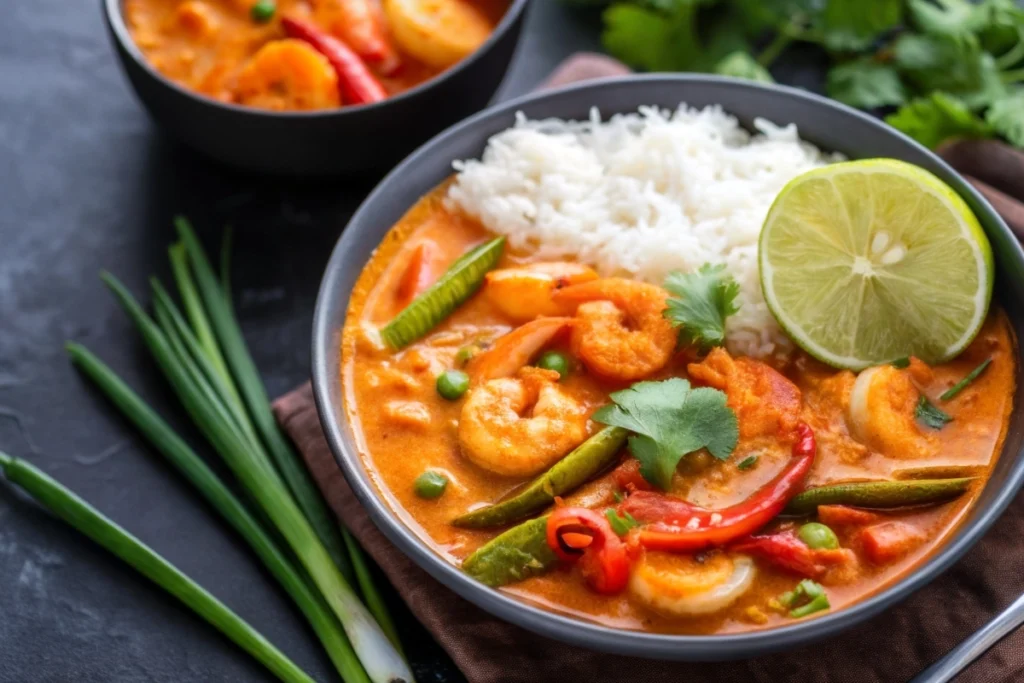
Serving Suggestions & Accompaniments
An expertly crafted bowl of Thai red curry with shrimp & coconut milk is only part of the experience. How you serve it can elevate the meal into a complete sensory delight. Here are some ideas to make your serving presentation truly special:
- Traditional Accompaniments: Serve the curry over steamed jasmine or basmati rice.
- Offer a side of lightly stir-fried vegetables to complement the rich sauce.
- Modern Plating Ideas: Use a wide, shallow bowl to showcase the vibrant colors of the dish.
- Garnish with extra Thai basil, sliced red chili, and a wedge of lime for a burst of freshness.
- Bullet Points for Serving: Serve hot over a bed of fragrant rice.
- Garnish with a mix of fresh herbs and lime.
- Consider a side of stir-fried vegetables for contrast.
These serving suggestions ensure that every spoonful of Thai red curry is a delightful blend of textures and flavors, making the dish not only delicious but also a feast for the eyes.
Common Mistakes & Troubleshooting
Even experienced cooks can encounter hiccups when preparing a dish as intricate as Thai red curry with shrimp & coconut milk. Here are some common pitfalls and tips to help you troubleshoot along the way:
- Overcooking the Shrimp: Shrimp cook quickly; overcooking can make them rubbery.
- Add shrimp only at the final stage and monitor closely.
- Balancing the Flavors: Ensure that the curry paste is evenly distributed by stirring continuously.
- If the sauce becomes too thick, add a splash of water or additional coconut milk.
- Inconsistent Sauce Texture: Maintain a gentle simmer instead of a rapid boil to prevent the coconut milk from separating.
- Stir frequently to keep the sauce smooth and well mixed.
- Bullet Points for Troubleshooting: Avoid overcooking shrimp by adding them later in the cooking process.
- Stir the curry paste evenly to ensure balanced flavors.
- Simmer gently to maintain the sauce’s consistency.
Following these troubleshooting tips can help you avoid common mistakes, ensuring that your final dish is as perfect as possible.
Frequently Asked Questions
What makes Thai red curry distinct from other curries?
- Thai Red Curry with Shrimp & Coconut Milk is distinguished by its vibrant curry paste, made with red chili, garlic, lemongrass, and kaffir lime leaves. This paste sets it apart with a unique blend of aromatic and spicy flavors that create an unforgettable taste.
Can I substitute the shrimp with another protein?
- Absolutely. While shrimp offers a delightful texture, you can replace them with chicken, tofu, or even a mix of seafood. Adjust cooking times accordingly to ensure each protein is cooked perfectly.
How can I adjust the spice level in my curry?
- The spice level can be modified by:
- Varying the amount of Thai red curry paste.
- Adding extra red chili for more heat.
- Including more coconut milk if you prefer a milder dish.
What vegetables work best in this curry?
- A variety of vegetables can enhance the dish, including:
- Sliced bell peppers.
- Bamboo shoots.
- Eggplant or zucchini.
- Fresh herbs like basil and cilantro for garnish.
How do I ensure the sauce remains smooth?
- The key is to:
- Stir continuously during the simmering process.
- Keep the heat on a low simmer rather than boiling rapidly.
- Adjust the liquid by adding a bit of water or extra coconut milk as needed.
Conclusion & Final Tips
Crafting an authentic Thai Red Curry with Shrimp & Coconut Milk is a journey that celebrates both tradition and innovation. This guide has provided you with everything you need—from history and ingredients to detailed cooking steps and creative variations—to master Thai Red Curry with Shrimp & Coconut Milk.

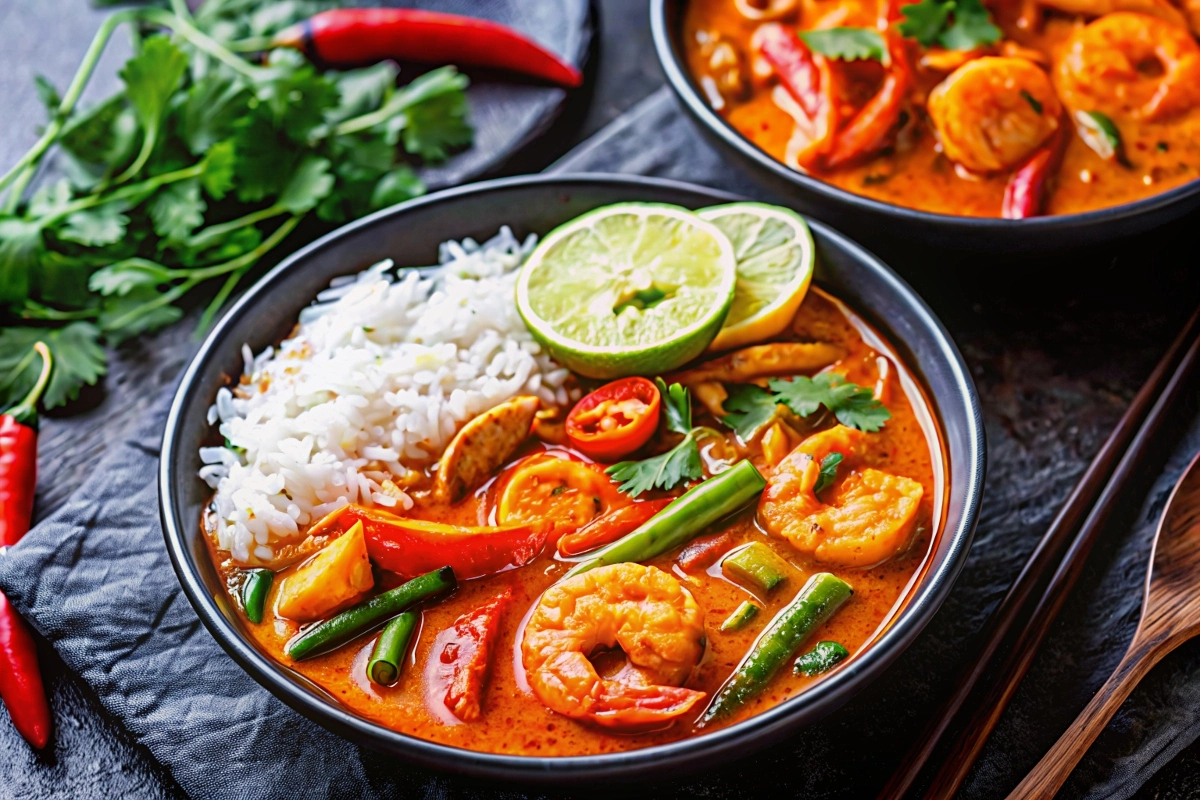
2 thoughts on “10 Steps to Master Authentic Thai Red Curry with Shrimp & Coconut Milk: A Complete Guide”